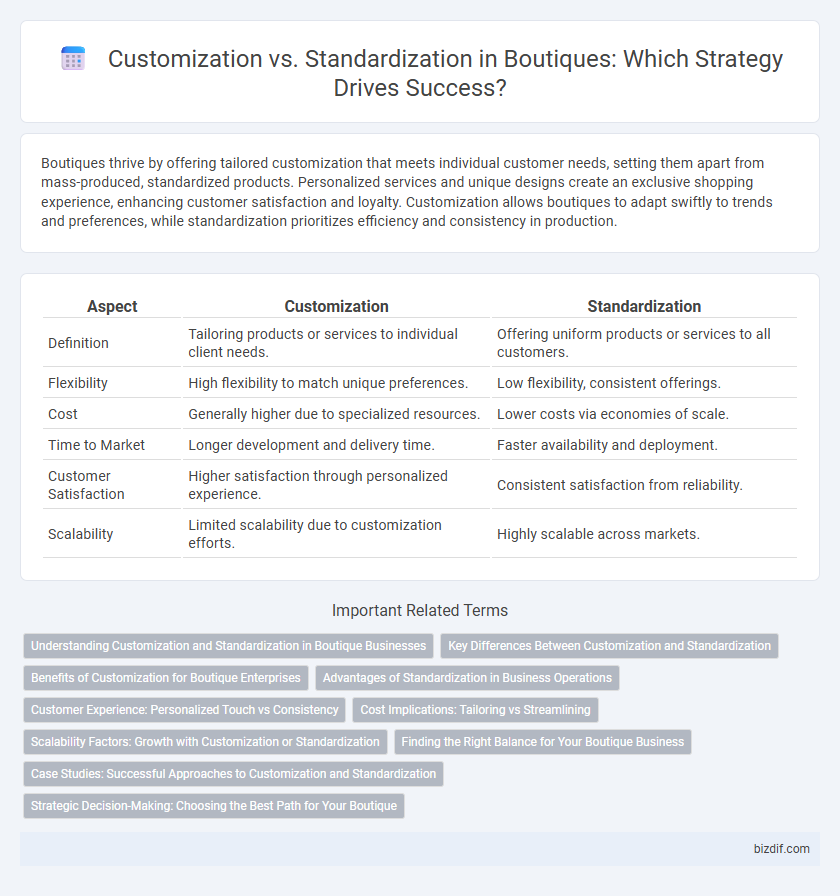Boutiques thrive by offering tailored customization that meets individual customer needs, setting them apart from mass-produced, standardized products. Personalized services and unique designs create an exclusive shopping experience, enhancing customer satisfaction and loyalty. Customization allows boutiques to adapt swiftly to trends and preferences, while standardization prioritizes efficiency and consistency in production.
Table of Comparison
| Aspect | Customization | Standardization |
|---|---|---|
| Definition | Tailoring products or services to individual client needs. | Offering uniform products or services to all customers. |
| Flexibility | High flexibility to match unique preferences. | Low flexibility, consistent offerings. |
| Cost | Generally higher due to specialized resources. | Lower costs via economies of scale. |
| Time to Market | Longer development and delivery time. | Faster availability and deployment. |
| Customer Satisfaction | Higher satisfaction through personalized experience. | Consistent satisfaction from reliability. |
| Scalability | Limited scalability due to customization efforts. | Highly scalable across markets. |
Understanding Customization and Standardization in Boutique Businesses
Boutique businesses thrive by leveraging customization to deliver unique, personalized products and services tailored to niche markets, enhancing customer loyalty and satisfaction. Standardization in boutiques ensures consistent quality, operational efficiency, and brand identity across all customer touchpoints, crucial for scalability and reliability. Balancing customization with standardization enables boutiques to meet diverse customer needs while maintaining streamlined processes and a cohesive brand experience.
Key Differences Between Customization and Standardization
Customization in boutiques involves tailoring products or services to individual customer preferences, enhancing personal connection and exclusivity, while standardization emphasizes uniformity and consistency across all offerings to streamline operations and reduce costs. Customization drives higher customer satisfaction and loyalty by addressing unique needs, whereas standardization ensures brand coherence and scalability. Key differences include flexibility in production, pricing strategies, and the degree of customer involvement throughout the purchasing process.
Benefits of Customization for Boutique Enterprises
Customization enables boutique enterprises to deliver tailored products and services that precisely meet individual customer preferences, enhancing customer satisfaction and loyalty. By leveraging unique designs and personalized experiences, boutiques differentiate themselves in competitive markets, attracting niche clientele willing to pay premium prices. This flexibility also allows boutiques to swiftly adapt to emerging trends and customer feedback, fostering innovation and sustained business growth.
Advantages of Standardization in Business Operations
Standardization in boutique business operations streamlines processes, ensuring consistent product quality and enhancing operational efficiency. It reduces costs by minimizing variability in materials and labor, facilitating easier training and scalable growth. Standardized procedures also improve customer satisfaction through predictable service delivery and faster turnaround times.
Customer Experience: Personalized Touch vs Consistency
Boutique businesses thrive by offering customization that enhances customer experience through personalized touches, creating a unique and memorable interaction tailored to individual preferences. Standardization ensures consistency, building trust and reliability by delivering uniform quality across all customer touchpoints. Balancing these approaches enables boutiques to meet diverse customer expectations while maintaining brand integrity and satisfaction.
Cost Implications: Tailoring vs Streamlining
Customization in boutiques often entails higher production costs due to bespoke materials, skilled craftsmanship, and extended design timelines, impacting overall pricing. Standardization streamlines operations by utilizing uniform processes and bulk purchasing, reducing per-unit expenses and enhancing profit margins. Balancing customization with scalable standardization optimizes cost management while preserving uniqueness and quality.
Scalability Factors: Growth with Customization or Standardization
Boutiques face critical scalability decisions between customization and standardization, where customization drives unique client experiences but often limits rapid growth due to resource intensity. Standardization enables streamlined operations and faster expansion by offering consistent, replicable products or services that appeal to broader markets. Balancing these approaches involves assessing market demand elasticity and operational capacity to scale efficiently while maintaining brand value.
Finding the Right Balance for Your Boutique Business
Finding the right balance between customization and standardization is essential for boutique businesses to meet unique customer preferences while maintaining operational efficiency. Customization allows boutiques to offer personalized products and services that differentiate them in competitive markets, whereas standardization streamlines processes and reduces costs. Analyzing customer data and market trends helps boutiques implement tailored strategies that blend both approaches for sustainable growth and enhanced customer satisfaction.
Case Studies: Successful Approaches to Customization and Standardization
Case studies reveal that successful boutiques leverage customization to enhance customer loyalty by tailoring products and services to individual preferences, as demonstrated by fashion brands like Gucci and Chanel. Conversely, standardization in boutiques such as Zara and Uniqlo maximizes operational efficiency and brand consistency across global markets. These approaches illustrate how balancing customization with standardization drives both customer satisfaction and scalable growth in the boutique industry.
Strategic Decision-Making: Choosing the Best Path for Your Boutique
Strategic decision-making in boutique management hinges on balancing customization and standardization to optimize customer satisfaction and operational efficiency. Customization enhances unique customer experiences and brand differentiation, while standardization streamlines processes and maintains consistent quality across all services and products. Analyzing market demand, target audience preferences, and cost implications guides boutiques in selecting a tailored approach that aligns with their business goals and competitive positioning.
Customization vs Standardization Infographic

 bizdif.com
bizdif.com